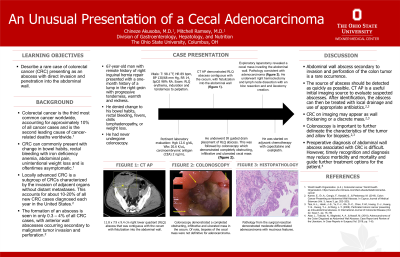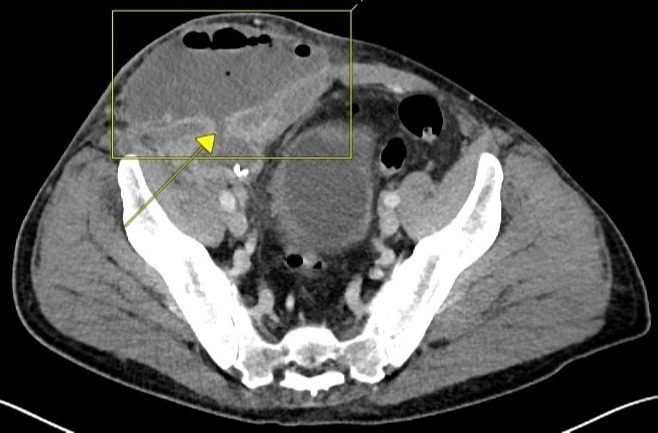Monday Poster Session
Category: Colon
P1681 - An Unusual Presentation of a Cecal Adenocarcinoma
Monday, October 23, 2023
10:30 AM - 4:15 PM PT
Location: Exhibit Hall

Has Audio
- CA
Chineze Akusoba, MD
The Ohio State University
Columbus, OH
Presenting Author(s)
Chineze Akusoba, MD1, Mitchell Ramsey, MD2
1The Ohio State University, Columbus, OH; 2The Ohio State Wexner Medical Center, Columbus, OH
Introduction: Colorectal cancer (CRC) is the third most common cancer in the United States, and can present insidiously and asymptomatically. It is rare for CRC to present as an abscess of the abdominal wall secondary to direct invasion and perforation of the colon. Here we report an unusual case of a CRC that presented as an abscess invading the abdominal wall.
Case Description/Methods: A 67-year-old male with remote right inguinal hernia repair presented with a one-month history of a lump in the right groin that had gradually become more swollen and tender. He denied change to his bowel habits, rectal bleeding, fevers, chills, lymphadenopathy, or weight loss. He denied a known personal or family history of cancer. He had never undergone colorectal cancer screening. On examination, he was afebrile and hemodynamically stable. He had a firm, tender swelling in the right groin with surrounding erythema. Laboratory evaluation was notable for a white blood cell count of 20.6 K/uL, hemoglobin of 12.6 g/dL and carcinoembryonic antigen (CEA) of 2 ng/mL. He underwent a CT abdomen/pelvis which demonstrated an 11.8 x 7.9 x 9.4 cm right lower quadrant (RLQ) abscess that was contiguous with the cecum with fistulization into the abdominal wall (Figure). He underwent IR guided drain placement in the RLQ abscess. The risks (including worsening perforation and infection) and benefits of colonoscopy were explained to the patient and a colonoscopy was pursued. Colonoscopy revealed a completely obstructing infiltrative and ulcerated mass in the cecum. Exploratory laparotomy was performed. A large cecal mass was found invading the abdominal wall, with extension through a fistulous tract. There was no evidence of distant metastasis. A right hemicolectomy and lymph node dissection was performed with en bloc resection of the involved part of the abdominal wall and end ileostomy creation. Pathology demonstrated moderately differentiated adenocarcinoma with mucinous features. The patient was referred to Medical Oncology for adjuvant chemotherapy, and commenced capecitabine and oxaliplatin.
Discussion: Locally advanced CRC can present as an abscess in an unusual location as the cancer spreads along tissue planes. Although direct invasion and perforation of the colon by CRC is rare, early recognition and diagnosis may reduce morbidity and mortality. CRC should be considered on the differential diagnosis for pericolonic abscesses or colonic perforation.

Disclosures:
Chineze Akusoba, MD1, Mitchell Ramsey, MD2. P1681 - An Unusual Presentation of a Cecal Adenocarcinoma, ACG 2023 Annual Scientific Meeting Abstracts. Vancouver, BC, Canada: American College of Gastroenterology.
1The Ohio State University, Columbus, OH; 2The Ohio State Wexner Medical Center, Columbus, OH
Introduction: Colorectal cancer (CRC) is the third most common cancer in the United States, and can present insidiously and asymptomatically. It is rare for CRC to present as an abscess of the abdominal wall secondary to direct invasion and perforation of the colon. Here we report an unusual case of a CRC that presented as an abscess invading the abdominal wall.
Case Description/Methods: A 67-year-old male with remote right inguinal hernia repair presented with a one-month history of a lump in the right groin that had gradually become more swollen and tender. He denied change to his bowel habits, rectal bleeding, fevers, chills, lymphadenopathy, or weight loss. He denied a known personal or family history of cancer. He had never undergone colorectal cancer screening. On examination, he was afebrile and hemodynamically stable. He had a firm, tender swelling in the right groin with surrounding erythema. Laboratory evaluation was notable for a white blood cell count of 20.6 K/uL, hemoglobin of 12.6 g/dL and carcinoembryonic antigen (CEA) of 2 ng/mL. He underwent a CT abdomen/pelvis which demonstrated an 11.8 x 7.9 x 9.4 cm right lower quadrant (RLQ) abscess that was contiguous with the cecum with fistulization into the abdominal wall (Figure). He underwent IR guided drain placement in the RLQ abscess. The risks (including worsening perforation and infection) and benefits of colonoscopy were explained to the patient and a colonoscopy was pursued. Colonoscopy revealed a completely obstructing infiltrative and ulcerated mass in the cecum. Exploratory laparotomy was performed. A large cecal mass was found invading the abdominal wall, with extension through a fistulous tract. There was no evidence of distant metastasis. A right hemicolectomy and lymph node dissection was performed with en bloc resection of the involved part of the abdominal wall and end ileostomy creation. Pathology demonstrated moderately differentiated adenocarcinoma with mucinous features. The patient was referred to Medical Oncology for adjuvant chemotherapy, and commenced capecitabine and oxaliplatin.
Discussion: Locally advanced CRC can present as an abscess in an unusual location as the cancer spreads along tissue planes. Although direct invasion and perforation of the colon by CRC is rare, early recognition and diagnosis may reduce morbidity and mortality. CRC should be considered on the differential diagnosis for pericolonic abscesses or colonic perforation.

Figure: Figure: Axial section of CT abdomen/pelvis with venous contrast demonstrating fistula tract (arrow) and abscess (box)
Disclosures:
Chineze Akusoba indicated no relevant financial relationships.
Mitchell Ramsey indicated no relevant financial relationships.
Chineze Akusoba, MD1, Mitchell Ramsey, MD2. P1681 - An Unusual Presentation of a Cecal Adenocarcinoma, ACG 2023 Annual Scientific Meeting Abstracts. Vancouver, BC, Canada: American College of Gastroenterology.
